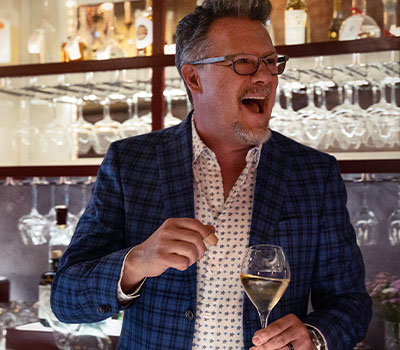Timothy Gardner opened Lula Drake Wine Parlour in November 2016. He felt that in Columbia, which lies between South Carolina’s food meccas of Charleston and Greenberg, he could be the only game in town when it came to a roster of sustainable, organic and biodynamic wines. His hunch paid off. In 2023, Lula Drake was nominated for a James Beard award for outstanding hospitality. This year, it’s just been nominated for another James Beard award, this time for outstanding wine and beverage program. “We’re so excited,” Gardner said. “This is even better [than last year], I think, because it really is our focus.” Gardner grew up working in restaurants before heading to Spain for a three-year gig blending wines. Now, he’s happy to be on the other side recommending wines at his own space. —Alissa Bica


What was your first job in the wine business?
I was a server, and then I moved to LA as a grad student at UCLA in film, television and theater. I would travel up to wine country during the summers and work wherever I could as a cellar rat. I ended up meeting a guy named Don Kreindler, whose family had the 21 Club in New York. He had moved to Los Angeles and was doing special events for 21 West. That’s where I really started to learn about wine and studying—he had run the beverage program at 21 Club. So, I’ve had these two dueling careers. I’m also a director; my wife and I also have another production company, we shoot commercials and documentaries.
Are people in South Carolina open to organic and biodynamic wines?
They are now. When I started, I knew there was going to be a huge learning curve. For the first six months, it went from the people that came in saying they wanted an oaky chardonnay to kind of clearing all of that out to allow for the people that were really looking for something interesting. And now, we have a phenomenal following. And we’ve had very little turnover [with staff]. We train diligently—when you come to work, you start on dish. It doesn’t matter who you are, you learn every part of the system, and then you learn the wines. Now we have clientele that come in and ask for a certain server or they’ll sit at the bar and say, “I don’t care what it is. I want to know what you have new this week.” In a tiny southern town, that’s pretty phenomenal.
What are your personal favorite wine regions right now?
I love unconventional winemakers and people that are stretching the boundaries of what we know. I’m a big Rhône fan. Right now, I’m most excited about Jean-Michel Stephan. I really focus on the farming more than the idea that we’re a natural wine bar. And John-Michel Stephan, everything he does has come through years of experimentation. He uses zero sulfur—you know what kind of mess you can get in with that—zero additives. He has three different northern Rhônes and the one I love—and it’s kind of blowing up on my menu right now—is the Côte Rôtie Côteaux de Bassenon. It’s a combination of syrah, sérène and viognier. Sérène is the tiny ancestor of syrah. It’s super concentrated and intense. I think [the blend] is 40 percent sérène, 40 percent syrah and 20 percent viognier. It’s so pure, balanced and focused. All his wines have this aliveness and energy to them. He uses a little bit of carbonic maceration, adds no yeast, ages a year to two in new and used French Oak. He does everything by hand. I’m talking pickaxes and plows, and all the vines are 50 to 100 years old. When people come into Lula Drake, they love the story not only of the place itself, but also the wines—it gives the servers a way to bond with the people.
I also love the lesser-known areas, like the Jura. And I just I love the renaissance of the Sicilian wines. Of course, I love Bordeaux and Burgundy but that’s not anything that we focus on. I feel like, at least in my city, if you want those, there are plenty of places to get them—and they can carry that kind of product without going broke. We’re a tiny establishment. So, in a lot of ways, the fact that we had very little money getting started kind of forced us into this area of interest that actually ended up benefiting us.
I love finding these value-oriented wines for the by-the-glass list. There’s Calea from Sicily. It’s nero d’Avela, fermented in tank and ages maybe four months. It’s one of these medium bodied, volcanic, deep soil, really earthy—it has so much depth and it’s so approachable. What I love is, you pour this into the glass and it’s like a very young pinot noir in the color. Everybody thinks this is gonna be so light and then this bomb drops. It’s so big and round, and you just don’t expect it. And you can buy that bottle retail for about sixteen dollars. It just blows your mind.
Are there any new categories of wine you added to your list this year?
I’ve been building up Madeira on the list. I love the process and the story—I love being able to tell people that the Declaration of Independence was toasted with Madeira and they don’t even know what it is. You’ve got them right there. I have an enormous collection of vintage Madeira, back to 1901. They were super expensive so, what I did was, over the course of four years, I would buy two or three bottles every year as they came available. In the same way that you can do anything with chenin blanc, from bone dry to incredibly sweet wines, Madeira is like that. The complexity is off the chart. Right now, it is one of our best sellers. People come in and spend a lot of money because they’ve worked their way up through that historic series. You can pour some of those for twelve dollars a pour and they’re incredible. They’re like the gateway drug to the vintage Madeiras.
We have a vintage D’Oliveira 1901 Malvasia. We just recently opened it because we built this group of Madeira drinkers. And it is phenomenal.
Have wine sales increased or decreased over the past year?
Increased incredibly. Once we got that James Beard nomination last year, our business doubled. On any given day the previous year, I could walk into Lula Drake and I would know 71 percent of the people that were there. Now I walk in, and honestly, I’ll see one or two people that I know. And it is the greatest feeling. There were three nominees from Colombia last year. And we saw this huge influx of people that would normally fly into Charleston and skip over or drive through Columbia to maybe get gas on the way to Greenville. Now, there are people from everywhere coming in and coming to the city and they’re visiting all these different establishments. It’s a wonderful thing. It’s grown exponentially.
Based in Los Angeles, California, Alissa Bica is the Associate Editor and Spirits Critic at Wine & Spirits. She is also a sommelier at 71 Above and co-runs the home wine tasting company, Côte Brune and Blonde. In any rare moments of free time, she writes about obscure grape varieties in the blog Off the Beaten Wine Path.
This story appears in the print issue of February 2024.
Like what you read? Subscribe today.




















